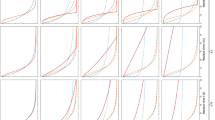Abstract
A physical theory explaining the anisotropic dispersion of water and solutes in biological tissues is introduced based on the phenomena of Taylor dispersion, in which highly diffusive solutes cycle between flowing and stagnant regions in the tissue, enhancing dispersion in the direction of microvascular flow. An effective diffusion equation is derived, for which the coefficient of dispersion in the axial direction (direction of capillary orientation) depends on the molecular diffusion coefficient, tissue perfusion, and vessel density. This analysis provides a homogenization that represents three-dimensional transport in capillary beds as an effectively one-dimensional phenomenon. The derived dispersion equation may be used to simulate the transport of solutes in tissues, such as in pharmacokinetic modeling. In addition, the analysis provides a physically based hypothesis for explaining dispersion anisotropy observed in diffusion-weighted imaging (DWI) and diffusion-tensor magnetic resonance imaging (DTMRI) and suggests the means of obtaining quantitative functional information on capillary vessel density from measurements of dispersion coefficients. It is shown that a failure to account for flow-mediated dispersion in vascular tissues may lead to misinterpretations of imaging data and significant overestimates of directional bias in molecular diffusivity in biological tissues. Measurement of the ratio of axial to transverse diffusivity may be combined with an independent measurement of perfusion to provide an estimate of capillary vessel density in the tissue.
Similar content being viewed by others
References
Bassingthwaighte, J.B., Goresky, C.A., 1984. Modeling in the analysis of solute and water exchange in the microvasculature. In Renkin, E.M., Michel, C.C. (Eds.). Handbook of Physiology. Sect. 2, The Cardiovascular System, vol. IV, The Microcirculation. Bethesda, MD, Am. Physiol. Soc., pp. 549–626
Beard, D.A., 2001. Computational framework for generating transport models from databases of microvascular anatomy. Ann. Biomed. Eng. 29(10), 837–843.
Beard, D.A., Schenkman, K.A., , 2003. Myocardial oxygenation in isolated hearts predicted by an anatomically realistic microvascular transport model. Am. J. Physiol. Heart Circ. Physiol. 285(5), H1826–H1836.
Beaulieu, C., 2002. The basis of anisotropic water diffusion in the nervous system—a technical review. NMR Biomed. 15(7–8), 435–455.
Chen, J., Song, S.K., , 2003. Remodeling of cardiac fiber structure after infarction in rats quantified with diffusion tensor MRI. Am. J. Physiol. Heart Circ. Physiol. 285(3), H946–H954.
Damiano, E.R., 1998. The effect of the endothelial-cell glycocalyx on the motion of red blood cells through capillaries. Microvasc. Res. 55(1), 77–91.
Feng, J., Weinbaum, S., 2000. Lubrication theory in highly compressible porous media: the mechanics of skiing, from red cells to humans. J. Fluid Mech. 422, 281–317.
Hrabe, J., Hrabetova, S., , 2004. A model of effective diffusion and tortuosity in the extracellular space of the brain. Biophys. J. 87(3), 1606–1617.
Huisman, T.A., 2003. Diffusion-weighted imaging: basic concepts and application in cerebral stroke and head trauma. Eur. Radiol. 13(10), 2283–2297.
Krogh, A., 1919. The number and distribution of capillaries in muscle with calculations of the oxygen pressure head necessary for supplying the tissue. J. Physiol. (Lond.) 52, 409–415.
Le Bihan, D., van Zijl, P., 2002. From the diffusion coefficient to the diffusion tensor. NMR Biomed. 15(7–8), 431–434.
Maas, L.C., Mukherjee, P., , 2004. Early laminar organization of the human cerebrum demonstrated with diffusion tensor imaging in extremely premature infants. Neuroimage 22(3), 1134–1140.
Minematsu, K., Li, L., , 1992. Diffusion-weighted magnetic resonance imaging: rapid and quantitative detection of focal brain ischemia. Neurology 42(1), 235–240.
Moseley, M.E., Kucharczyk, J., , 1990. Diffusion-weighted MR imaging of acute stroke: correlation with T2-weighted and magnetic susceptibility-enhanced MR imaging in cats. AJNR Am. J. Neuroradiol. 11(3), 423–429.
Partridge, S.C., Mukherjee, P., , 2004. Diffusion tensor imaging: serial quantitation of white matter tract maturity in premature newborns. Neuroimage 22(3), 1302–1314.
Pries, A.R., Secomb, T.W., , 1996. Biophysical aspects of blood flow in the microvasculature. Cardiovasc. Res. 32(4), 654–667.
Scollan, D.F., Holmes, A., , 1998. Histological validation of myocardial microstructure obtained from diffusion tensor magnetic resonance imaging. Am. J. Physiol. 275(6 Pt 2), H2308–H2318.
Scollan, D.F., Holmes, A., , 2000. Reconstruction of cardiac ventricular geometry and fiber orientation using magnetic resonance imaging. Ann. Biomed. Eng. 28(8), 934–944.
Secomb, T.W., Hsu, R., 1994. Simulation of O2 transport in skeletal muscle: diffusive exchange between arterioles and capillaries. Am. J. Physiol. 267(3 Pt 2), H1214–H1221.
Secomb, T.W., Hsu, R., , 1998. A model for red blood cell motion in glycocalyx-lined capillaries. Am. J. Physiol. Heart Circ. Physiol. 43(3), H1016–H1022.
Sotak, C.H., 2002. The role of diffusion tensor imaging in the evaluation of ischemic brain injury—a review. NMR Biomed. 15(7–8), 561–569.
Taylor, G.I., 1953. Dispersion of solute matter in solvent flowing slowly through a tube. Proc. R. Soc. (Lond.), Ser. A 219, 186–203.
Toosy, A.T., Ciccarelli, O., , 2004. Characterizing function–structure relationships in the human visual system with functional MRI and diffusion-tensor imaging. Neuroimage 21(4), 1452–1463.
Author information
Authors and Affiliations
Corresponding author
Rights and permissions
About this article
Cite this article
Beard, D.A., Wu, F. Apparent Diffusivity and Taylor Dispersion of Water and Solutes in Capillary Beds. Bull. Math. Biol. 71, 1366–1377 (2009). https://doi.org/10.1007/s11538-009-9405-y
Received:
Accepted:
Published:
Issue Date:
DOI: https://doi.org/10.1007/s11538-009-9405-y




